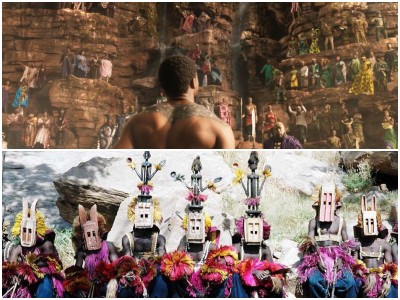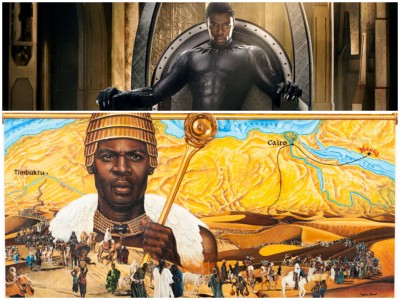The Cultural Influences of Marvel’s Black Panther
The secret city of Wakanda is a living and breathing world and it is definitely a Marvel to behold in the big screen. The film owes its afrofuturistic aesthetics to costume designer, Ruth E. Carter and production designer, Hannah Beachler. The crew of creatives strived to make the film be a rich representation of Africa by showcasing the country’s diverse cultures through their many languages, mythology, history, couture, and rituals. With all of these elements together it has led to a refreshing cinematic experience. With the overall film being an authentic and respectful adaptation of their culture outside of its superheroics. Here in Flipgeeks our writers Nadine Flores, GP Manalo, and Angelo Delos Trinos will recount the cultural influences as depicted in Marvel Studios’ Black Panther.
Disclaimer: This will be an itemized listicle on the things that stuck out to us in the film, it is not necessarily everything that was in the film — so chances are we may have missed a few things. More so, the following cultural influences may have been officially confirmed by the filmmakers themselves or subjected to speculation by the writers’ research. Lastly, we will not be talking much about Afrofuturism as it is already discussed on a separate article, also written by Angelo Delos Trinos. If you would like to know more about the its significance to the film or its cultural background you may click the hyperlink attached.
1.) The Dogon Tribe and the legacy of Mansa Musa inspired the creation of Wakanda

Top: The many tribes of Wakanda gathered together in Warrior Falls. Photo by Walt Disney Pictures. Bottom: Dogon Village in the Bandiagara Region of Mali.
Dogon
The Dogon people of West Africa has baffled scientists and scholars with their advanced knowledge of astronomy, claiming that amphibious beings called the “Nommos” from the Sirius star system visited them centuries ago and taught them this. The Dogon were already well aware of the fact that Sirius, which is a bright star in the Canis Major constellation, actually consists of two stars: Sirius A and B, before Western astronomers even learned of it. What’s more astonishing is that the naked eye can only see Sirius A, yet the Dogon Tribe have ceremonies aligned with the movements of Sirius B. Additionally, they also know that Saturn has rings and four moons, something that also cannot be observed without a powerful telescope. Robert Temple published a book about the Dogon called “The Sirius Mystery” in 1976, putting forward these claims and has since been subject to debunking due to inconsistencies, errors, and Temple’s view of the Dogon people. Ian Ridpath wrote in an article for The Skeptical Inquirer, criticizing Temple:
“It is all too easy for Westerners to think of African Tribes as isolated, uneducated, and ignorant. But the Dogon are not isolated… Any number of travelers could have come to their midst, or Dogon tribesmen could have journeyed to the coast, where they might have met astronomically informed seamen. The Dogon have been in contact with Europeans since at least the late nineteenth century. Nor are they uneducated and ignorant… French schools have existed in the Dogon area since 1907.”
Today, Dogon Country is one of Mali’s biggest tourist attractions, causing changes in their cultural and social organization. There are villages where the people have converted from animist beliefs into Christianity and Islam, and the economy has shifted from agriculture and herding leaning now towards tourism. Modernization continues to affect the Dogon people that they now struggle to keep in touch with their culture.
Ruth Carter, Black Panther’s costume designer, stated in an interview that the Dogons are one of the inspirations behind the film. References to the Kananga masks of the Dogon can be seen in the film.
References:
Mansa Musa
Even with a net worth of $108.9 billion, the Founder and current CEO of Amazon.com, Jeff Bezos pales in comparison to the richest man in history–King Mansa Musa I of Mali–whose inflation-adjusted net worth tops at an estimated $400 billion. He made this fortune by exploiting the country’s salt and gold production, but his heirs were unable to keep it after his death, due to civil wars and invading armies. He is theorized to be one of the inspirations behind the creation of Black Panther as a character, although neither Jack Kirby nor Stan Lee has confirmed this.
Mansa Musa is most notably known for his grand expedition as pilgrimage to Mecca, that consisted of a 60,000-strong caravan, including 1,000 attendants, 100 camels loaded with gold, plenty of the emperor’s own personal musicians, and 500 slaves bearing gold staffs. It was during this trip where he negatively influenced the economy of Cairo, Egypt. He gave away so much gold that it declined in value, causing an inflation to the prices of food and other commodities. Cairo’s gold market took a decade to recover from the inflation. Mansa Musa became so popular that he was even featured on one of the most important world maps of Medieval Europe: The 1375 Catalan Atlas.
As grand as that may sound, it still doesn’t compare to T’Challa’s net worth. According to Time, the King of Wakanda’s net worth is a staggering $90.7 trillion–over 200 times Mansa Musa’s. This makes Black Panther as the wealthiest fictional character of all time. Step aside, Scrooge McDuck (who’s at $65.5 billion)!
T’Challa may have only inherited his fortune, but Wakanda’s history is sure similar to Mansa Musa. Wakanda owes its riches to a meteoric ore containing vibranium, that they then exported in small quantities. In the comics, it was under T’Challa’s rule where Wakanda struggled to maintain their traditions in spite of modernization (just like how Mansa Musa urbanized Timbuktu through establishment of schools and other facilities), and upon his return he further parlayed the Vibranium deposit into even greater wealth.
References:

























